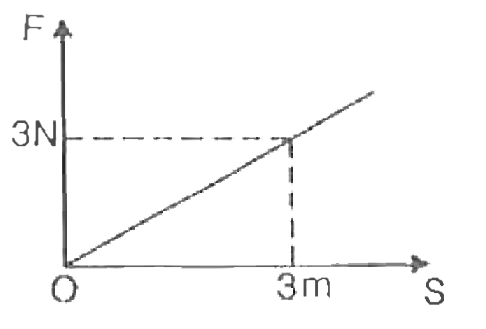A body is under the action of two equal and op- posite forces, each 5 N. The body is displaced by 5 m, then the work done is
25 J
−25J
50 J
zero
The correct Answer is:D
To solve the problem, we need to calculate the work done on a body that is acted upon by two equal and opposite forces, each of 5 N, while the body is displaced by 5 m.
1. Identify the Forces:
- We have two forces acting on the body:
- Force 1 (F1) = 5 N in the positive direction.
- Force 2 (F2) = 5 N in the negative direction.
2. Determine the Net Force:
- Since the forces are equal in magnitude and opposite in direction, the net force (F_net) acting on the body is:
Fnet=F1−F2=5N−5N=0N
3. Understand the Displacement:
- The body is displaced by a distance (s) of 5 m.
4. Calculate Work Done:
- The formula for work done (W) is given by:
W=F⋅s⋅cos(θ)
- Here, θ is the angle between the force and the direction of displacement. However, since the net force is zero (as established in step 2), we can conclude that:
Wnet=0J
- This is because, despite the displacement, the opposing forces cancel each other out, resulting in no net work done on the body.
5. Conclusion:
- Therefore, the total work done on the body is:
W=0J
Final Answer:
The work done is 0 Joules.
- We have two forces acting on the body:
- Force 1 (F1) = 5 N in the positive direction.
- Force 2 (F2) = 5 N in the negative direction.
- Since the forces are equal in magnitude and opposite in direction, the net force (F_net) acting on the body is:
Fnet=F1−F2=5N−5N=0N
- The body is displaced by a distance (s) of 5 m.
- The formula for work done (W) is given by:
W=F⋅s⋅cos(θ)
- Here, θ is the angle between the force and the direction of displacement. However, since the net force is zero (as established in step 2), we can conclude that:
Wnet=0J
- This is because, despite the displacement, the opposing forces cancel each other out, resulting in no net work done on the body.
- Therefore, the total work done on the body is:
W=0J
The work done is 0 Joules.
Topper's Solved these Questions
Similar Questions
A body covers a distance of 4m under the action of force F = (17 – 4x)N where x is the distance in metres. The work done by the force is
View SolutionA body moves in a straight line under the action of a variable force which changes with displacement of the body as shown in the figure. What is the work done when the body has been displaced through (i) 0.2 m, (ii) 0.4 m ?

View Solution
Knowledge Check
A body is under the action of two equal and opposite forces, each of 10 N. The body is displaced by 5 m. The work done is
A+50JB−50JC100JDZeroA body is under the action of two equal and oppositely directed forces and the body is rotating with constant non-zero angular acceleration. Which of the following cannot be the separation between the lines of action of the forces ?
A1 mB0.4 mC0.25 mDzeroA body is inequibrium under the action of three coplanar forces, then
Athey must act in a straight lineBthey must meet in pointCtheir horizontal and vertical components must be equalDnone of these
A body moves from point A to point B under the action of a force varying in magnitude as shown in the force displacement graph. Find total work done by the force :
View SolutionA body covers a distance of 4m under the action of force F=(17-4x)N where x is the distance in metres. The work done by the force is
View SolutionA body covers a distance of 4m under the action of force F=(17-4x)N where x is the distance in metres.The work done by the force is
View SolutionA body covers a distance of 4m under the action of force F=(17-4x)N where x is the distance in metres.The work done by the force is
View SolutionA body is under the action of two mutually perpendicular forces of 3 N and 4 N. The resultant force acting on the body is
View Solution
